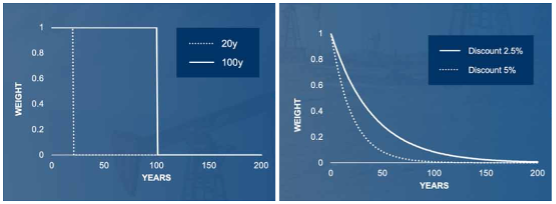Metrics matter

Metrics matter

Measuring climate impact meaningfully
An effective strategy for reducing greenhouse gas emissions requires a good understanding of the impacts of different greenhouse gases (GHGs), how they compare, and how their effects unfold over time.
Current metrics, Global Warming Potential (GWP) for example, are ambiguous, resulting in a wide range of values describing specific impacts of short-lived climate pollutants (SLCPs) like methane, without a scientific basis for selecting which value to use. This ambiguity complicates and delays abatement by making the impact of abatement actions unclear.
That’s why my colleague Robert Kleinberg, a Senior Research Scholar at Columbia University's Center on Global Energy Policy, and I have been working on a new impact measure for GHGs that more accurately captures long-and short-term global warming effects—to better prioritize climate action and make smarter decisions on the road to net zero. Meet Present Global Warming (PGW).
Comparing GHGs beyond CO2
Human activity has increased the atmospheric concentration of several greenhouse gases—and each of them contributes to climate change.
The potency of a GHG is typically measured by considering
- how long it lasts in the atmosphere, and
- how much heat it traps while it is present in the atmosphere (“radiative efficiency”).
SLCPs are GHGs or other compounds that have higher radiative efficiencies but shorter atmospheric lifetimes than carbon dioxide. The most significant SLCP is methane. While its atmospheric lifetime is much shorter than carbon dioxide (around 12 years, compared with centuries)—its heat-trapping ability while in the atmosphere is 120 times that of CO2.
Any emission reduction effort is incomplete if it ignores compounds other than CO2—and effective planning requires the use of metrics that quantify the potency of those other compounds so that their potential impacts can be easily evaluated, compared, and tackled in the right order.
The atmospheric lifetime and radiative efficiency of different SLCPs are typically measured accurately. Prioritizing abatement requires combining this information into a single number that represents the potency of the SLCP, but there is no universally accepted metric to provide that number.
GWP and variations of it are among the more frequently referenced metrics. Yet they do not amount to a common standard, as they require picking a timeframe. People choose different timeframes, resulting in wildly different values for climate impact.
We are proposing an alternative metric to more accurately quantify the impact of SLCPs such as methane, and standardize the quantification of climate impact across GHGs.
Building on the logic of GWP, PGW borrows from an established concept in economics to give a more meaningful measure of a GHG's impact over time. Crucially, it helps to direct action where it makes the biggest difference.
Accounting for time: enter PGW
The most common metric to quantify and compare the impact of different GHGs is GWP.
It compares the average “radiative forcing”—the product of the radiative efficiency and the atmospheric lifetime—from an emission of a given SLCP over a defined timeframe to the average radiative forcing from an emission of CO2 over the same timeframe.
The radiative forcing is weighted by a step function that equally weights everything within the chosen timeframe and excludes everything outside that timeframe. This ‘in or out’ approach masks the nuances in impact between different SLCPs and hides opportunities for quick wins from view. It is also hugely dependent on the timeframe picked: the GWP for methane varies by a factor of three among common timeframes!
Meanwhile, our new measure, PGW, determines the impact of future climate effects using a diminishing weighting function similar to the one used to account for future revenue streams in an economic net present value (NPV) calculation.
Unlike GWP, PGW applies a varying weight, in which each successive year is given incrementally less weight.

The principle here is that PGW can be used to quantify the environmental impact of an SLCP at any point in the future by discounting levels by an amount dependent on how far in the future we look.
In addition, by integrating climate effects to infinity and appropriately weighting future climate effects, PGW not only allows us to consider short- and long-term effects simultaneously, it allows pollutants with different lifetimes to be evaluated consistently.
Discount rates are commonly used by governments, researchers, and corporations to inform decisions where short-and long-term effects need to be considered. PGW leverages this established track record to offer a new, more meaningful way of evaluating climate impact of all GHGs, with a view to driving more effective action.
Rather than selecting a timeframe arbitrarily, PGW is computed simply by using the same discount rate already used elsewhere. This construction allows PGW to be consistent with other metrics that consider future effects. Moreover, PGW is stable: all common discount rates result in nearly the same methane PGW.
This makes PGW uniquely useful compared to commonly used step function metrics, especially where the choice of timeframe is not always clear and the value of the metric changes dramatically at different timeframes.
Using the default discount rate of 2.5% annually—consistent with the discount widely used by researchers and policymakers—PGW values methane as 50 times more potent than carbon dioxide.
Our full paper, which was published in the peer-reviewed Environmental Research Letters (Volume 17, 2022), can be viewed here: https://iopscience.iop.org/article/10.1088/1748-9326/ac9f58
What’s next?
The methane team here at SLB has built PGW into our methane digital platform as a metric to help our users make better calls on their emission reduction strategies.
We will also continue to promote PGW to key stakeholders in the global methane and wider energy community. When time is of the essence, prioritizing for impact matters.

